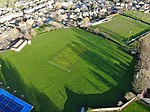Bourne Castle

Bourne Castle was a castle in the market town of Bourne in southern Lincolnshire (grid reference TF095199). A Norman castle was built by Baldwin FitzGilbert (son of Gilbert Fitz Richard, of the De Clare family). In medieval times there was motte and double bailey castle which formed an unusual concentric plan. The castle was destroyed after being used by Cromwell's troops in 1645 and a farmhouse was built on the site. Traces of the enclosed mound and inner and outer moats (forming part of the Bourne Eau) are all that now survive.The land the castle occupied is now a park, known as the Wellhead Park, owned by the Bourne United Charities and is open to the public.The first reference to Bourne Castle was in the 1179/80 Pipe Roll. There are other mentions of Bourne Castle throughout its history including the IPM (Inquisition Post Mortem) and the Close Rolls.
Excerpt from the Wikipedia article Bourne Castle (License: CC BY-SA 3.0, Authors, Images).Bourne Castle
South Street, South Kesteven Bourne
Geographical coordinates (GPS) Address Nearby Places Show on map
Geographical coordinates (GPS)
| Latitude | Longitude |
|---|---|
| N 52.76561 ° | E -0.37856 ° |
Address
Wellhead Cottage
South Street 17
PE10 9LY South Kesteven, Bourne
England, United Kingdom
Open on Google Maps









